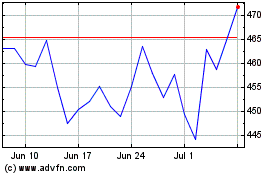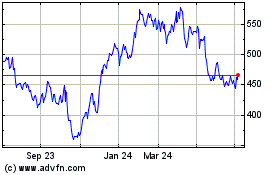U.K. Investigators Uncover Flight-Data Issue Involving Airbus Jetliners
May 14 2016 - 10:36PM
Dow Jones News
By Andy Pasztor
British air-crash investigators looking into an incident last
year involving an easyJet PLC flight have documented how a bug in
an electronic flight-data calculator on many Airbus Group SE
jetliners could lead to takeoff problems.
The potential hazard and steps to eliminate it were disclosed in
a report released last week by Britain's Air Accidents
Investigation Branch.
Pilots of an easyJet Airbus A319 unintentionally altered some
touchscreen settings on a computerized takeoff calculator -- called
an electronic flight bag -- but failed to recognize the changes
until after takeoff from Belfast International Airport last June,
according to the report. Investigators determined that as a result
of the data confusion, the crew set engine thrust so that the jet
carrying 161 people used up all but the last roughly 650 feet of
the strip before becoming airborne, a significantly smaller safety
margin than normal.
Airbus and easyJet participated in the investigation, agreed
with its main conclusions and have taken steps to prevent a repeat
of the incident.
There were no injuries and the jet wasn't damaged, but the event
highlighted the broader danger of pilots mistakenly entering the
wrong takeoff parameters into such computers. Data-integrity issues
and potential pilot distractions resulting in programming slip-ups
prior to takeoff have long been identified as major hazards for all
types of commercial aircraft, including models made by Boeing Co.
and other manufacturers.
The AAIB report, which indicated European air-safety regulators
and Airbus are pursuing various initiatives to reduce those risks,
further highlights the work remaining to be done. Pilots typically
double-check parameters before takeoff, but in the easyJet incident
company rules didn't require that specific safeguard. The AAIB
previously investigated two other easyJet takeoff incidents in 2015
in which crews relied on incorrect computerized takeoff-performance
data. Neither of those events resulted in damage or injuries.
Still, last week's report emphasized the importance of each
pilot cross-checking data entered into such electronic flight bags
prior to takeoff. The report notes that Airbus has made some
adjustments and is studying software revisions and other changes
intended to catch pilot errors that can introduce incorrect data
into such computers. One of the major changes was available to
airlines prior to the Belfast incident, but investigators
determined that easyJet hadn't installed the updated software nor
adopted Airbus's recommendations regarding pilot
cross-checking.
EasyJet is evaluating a number of procedural changes, according
to the British report. And prompted by the Belfast incident, Airbus
last October urged operators to catch data-entry mistakes by
requiring "an independent computation made by both pilots" prior to
the takeoff roll.
Also according to the AAIB, the European Aviation Safety Agency
recently determined that when it comes to pre-takeoff data hazards,
the "risk level and its trend need to be monitored
continuously."
Long before the June 2015 mix-up, numerous other airlines
world-wide suffered a series of data-input problems prior to
takeoff, some involving larger aircraft and more-hazardous
incidents or accidents.
In March 2014, a US Airways Airbus A320 struck its tail on a
Philadelphia runway after the crew rejected takeoff following a
computer glitch caused by mistaken data input. The captain
initially opted to try to become airborne despite the loss of
critical speed measurements and an automated warning he didn't
understand. During the next several seconds, the captain commanded
the nose of the plane to move sharply up and down three times,
according to a National Transportation Safety Board report. The jet
bounced on the runway, climbed to an altitude of 15 feet and then
slammed back down, collapsing the nose gear, according to
investigators. There were no injuries.
One of the most harrowing events occurred five years earlier in
Melbourne, Australia, when the co-pilot of an Emirates Airline
Airbus A340 mistakenly entered a takeoff weight into the electronic
flight bag, or cockpit computer, that was 100 tons less than the
plane's actual weight. Calculations for engine thrust and takeoff
distance were based on the erroneous weight data, which the captain
also overlooked.
The jet initially failed to become airborne when the control
stick was used to try to raise the nose and climb. The captain
applied full power and then the four-engine jet, carrying 275
people and bound for Dubai, hit some lights and antennas at the end
of the strip. It rolled past the paved runway for about four
seconds before starting to noticeably climb, according to
Australian investigators. It took the pilots five minutes to
realize their computational error, and investigators also found
significant damage to the underside of the fuselage. After dumping
fuel, the plane landed back at the airport about an hour later
without any injuries.
Write to Andy Pasztor at andy.pasztor@wsj.com
(END) Dow Jones Newswires
May 14, 2016 22:21 ET (02:21 GMT)
Copyright (c) 2016 Dow Jones & Company, Inc.
Easyjet (LSE:EZJ)
Historical Stock Chart
From Mar 2024 to Apr 2024

Easyjet (LSE:EZJ)
Historical Stock Chart
From Apr 2023 to Apr 2024
